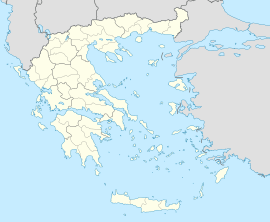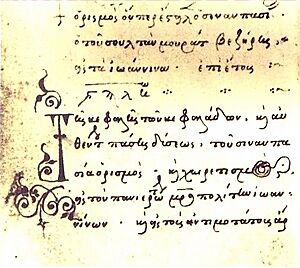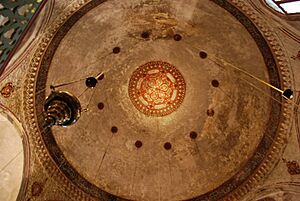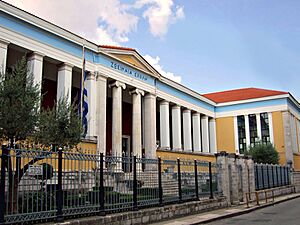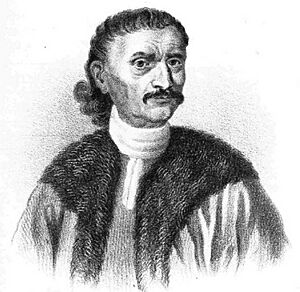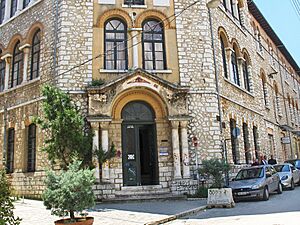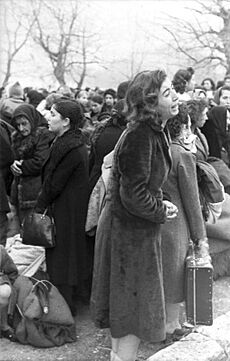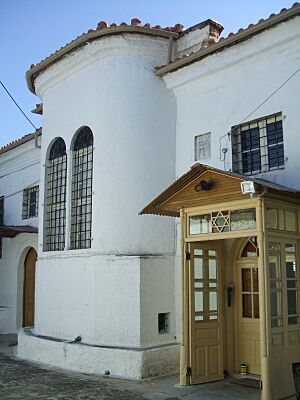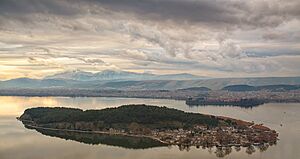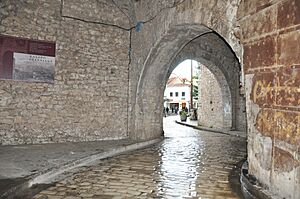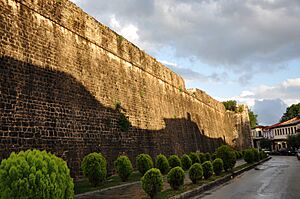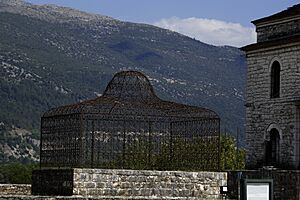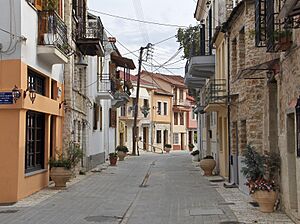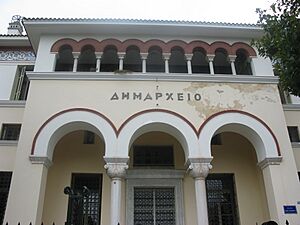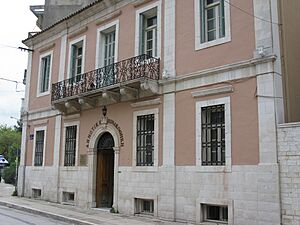Ioannina facts for kids
Quick facts for kids
Ioannina
Ιωάννινα
|
|
|---|---|
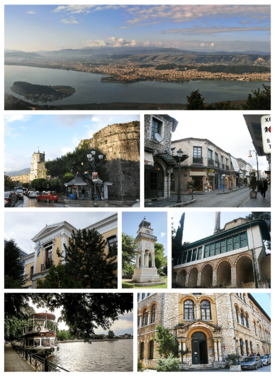 Clockwise from top: Panoramic view of Lake Pamvotis and the city of Ioannina from Mitsikeli, Old Town, Municipal Clock Tower of Ioannina, Municipal Ethnographic Museum of Ioannina, Kaplaneios School, Ferry to the Island, Post Office, and the Castle of Ioannina.
|
|
| Country | Greece |
| Administrative region | Epirus |
| Regional unit | Ioannina |
| Area | |
| • Municipality | 403.32 km2 (155.72 sq mi) |
| • Municipal unit | 47.44 km2 (18.32 sq mi) |
| Elevation | 480 m (1,570 ft) |
| Population
(2021)
|
|
| • Municipality | 113,978 |
| • Municipality density | 282.599/km2 (731.929/sq mi) |
| • Municipal unit | 81,627 |
| • Municipal unit density | 1,720.64/km2 (4,456.4/sq mi) |
| Demonym(s) | Yanniote (Gianniote)/ Ioannite (formal) |
| Community | |
| • Population | 64,896 (2021) |
| • Area (km2) | 17.355 |
| Time zone | UTC+2 (EET) |
| • Summer (DST) | UTC+3 (EEST) |
| Postal code |
45x xx
|
| Area code(s) | 26510 |
| Vehicle registration | ΙΝ |
Ioannina (Greek: Ιωάννινα Ioánnina), also called Yannena (Γιάννενα Yánnena), is a big city in northwestern Greece. It is the capital of the Ioannina region and the Epirus area. In 2021, the city had about 64,896 people living there. The whole area around it, called the municipality, had 113,978 people.
Ioannina is located about 500 meters (1,640 feet) above sea level. It sits on the western shore of Lake Pamvotis. The city is about 410 kilometers (255 miles) northwest of Athens, the capital of Greece. It's also 260 kilometers (162 miles) southwest of Thessaloniki.
People traditionally believe that the Byzantine Emperor Justinian founded the city in the 6th century AD. However, recent discoveries show that people lived here even earlier, in Hellenistic times. Ioannina became very important between the 13th and 15th centuries. It was part of the Despotate of Epirus after the Fourth Crusade. Many rich families from Constantinople moved here in 1204, making the city very successful and independent.
In 1430, Ioannina became part of the Ottoman Empire. It was an important center for the modern Greek Enlightenment in the 18th and 19th centuries. Greece took control of Ioannina in 1913 after the Balkan Wars.
Today, Ioannina has many green spaces and parks, like Molos (by the lake) and Litharitsia Park. It has two hospitals and is home to the University of Ioannina. The city's symbol shows the Byzantine Emperor Justinian with a picture of the ancient theater of Dodona.
Contents
- What's in a Name?
- A Look at Ioannina's Past
- The Jewish Community of Ioannina
- Ioannina's Location and Climate
- Population Changes Over Time
- Places to See in Ioannina
- Learning in Ioannina
- Local Products and Food
- Media and Technology
- International Connections
- Famous People from Ioannina
- Sports in Ioannina
- Getting Around Ioannina
- Images for kids
- See also
What's in a Name?
The official name, Ioannina, probably comes from Agioannina. This means 'place of St. John'. It might be linked to a monastery built for St. John the Baptist. This monastery was in the area where the Ioannina Castle is now.
Another idea is that the city was named after Ioannina, the daughter of Belisarius. He was a general for Emperor Justinian.
In Greek, there are two ways to say the name. Ioannina is the formal and older name. But most people use Yannena or Yannina (Greek: Γιάννενα, Γιάννινα). This is the common way to say it in everyday Greek.
A Look at Ioannina's Past
Ancient Times & Early Middle Ages
People have lived in the Ioannina area for a very long time. Signs of human life from 24,000 years ago have been found in a cave called Kastritsa. In ancient times, the Molossians lived here. Four of their settlements have been found in the area.
No one knows exactly when Ioannina was founded. Some think it's the "well-fortified" city mentioned by the historian Procopius. He said Emperor Justinian I built it for people from ancient Euroia. But there's no strong proof for this idea.
Archaeologists have found old walls from the Hellenistic period. These walls were later used when the fortress was rebuilt by the Byzantines and Ottomans.
The name Ioannina first appeared in 879. It was in documents from a church meeting, mentioning a bishop from Ioannina. In 1020, Emperor Basil II made the local church part of the Archbishopric of Ohrid. The city walls and parts of the Ioannina Castle were built in the 10th century. More parts were added in the late 11th century.
After the Fourth Crusade in 1204, Ioannina became part of the new Despotate of Epirus. This state was founded by Michael I Komnenos Doukas.
Late Middle Ages: A Time of Change (1204–1430)
Under Michael I, the city grew bigger and its defenses were made stronger. Many people who fled Constantinople after it was attacked in 1204 came to Ioannina. Michael helped them settle, turning the city into a safe place. This made Ioannina more important and richer.
In 1319, Emperor Andronikos II Palaiologos gave the city special rights and freedom. This was after the last local ruler was killed. A Jewish community also lived in the city at this time.
Ioannina was taken by the Serb ruler Stephen Dushan in 1356. Later, in 1366, Thomas II Preljubović became the new ruler. He was not popular, but he defended the city from attacks.
After Thomas was killed in 1384, the people of Ioannina invited Esau de' Buondelmonti to rule. He brought back people who had been exiled and returned their property. In 1389, an Ottoman army helped Esau defend the city from attacks.
In 1411, after Esau's death, the people asked Carlo I Tocco to be their ruler. He expanded his lands and reunited the old Epirote area. Ioannina became his summer capital. In 1430, an Ottoman army arrived. The city surrendered after the Ottoman leader, Sinan Pasha, promised to protect the city and its freedom.
Ottoman Rule: A Long Period (1430–1913)
Under the Ottomans, Ioannina remained an important center. It had a period of peace and growth. Early records from 1564 show that most people living in the city were Christian.
In 1611, a revolt led by Dionysius the Philosopher caused problems for the city. After the revolt, Christians were not allowed to live inside the castle walls. They had to move outside. The Aslan Pasha Mosque was built where a church used to be. Many Christian nobles also converted to Islam during this time.
A Hub of Learning (17th–18th centuries)
Even with these changes, Ioannina kept its Christian majority. The Greek language was widely spoken. The city became very rich and had a lot of cultural activity. Many important schools were started. People from Ioannina traded with big European cities like Venice.
Many wealthy merchants from Ioannina, living abroad, helped their hometown. They set up printing presses in Venice, publishing over 1,600 books for Greeks under Ottoman rule. These books were about history, religion, and science.
Schools like the Epiphaniou School (1647) and the Gioumeios School (1676) were founded. The Balaneios School taught philosophy, theology, and math. Famous thinkers of the Greek Enlightenment worked here.
The Maroutsaia School opened in 1742. It taught science and philosophy. Later, it reopened as the Kaplaneios School thanks to a gift from Zoes Kaplanes. Its headmaster, Athanasios Psalidas, created a huge library and science labs. These schools helped the Greek Enlightenment grow.
Ali Pasha's Era (1788–1822)
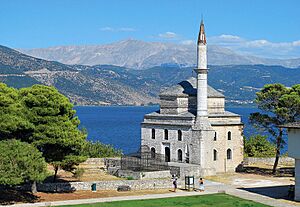
In 1788, Ioannina became the center of the area ruled by Ali Pasha of Yannina. He was a powerful Ottoman-Albanian leader. His court attracted many important figures of the Greek War of Independence. During his rule, Ioannina was very successful economically and intellectually.
Ali Pasha tried to break away from the Ottoman government. In 1820, he was declared a traitor, and Ioannina was attacked by Turkish troops. Ali Pasha was killed in 1822 on the island in the lake.
The Last Ottoman Century (1822–1913)
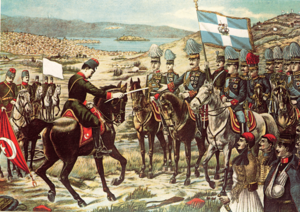
The Zosimaia School was founded in 1828, after the Greek War of Independence began. It was paid for by the Zosimas brothers. It taught Greek, philosophy, and foreign languages.
In 1869, a large part of Ioannina was destroyed by fire. The market was quickly rebuilt. People from Ioannina living abroad helped pay for many churches, schools, and other buildings. The first branch of the Ottoman Bank in Greece opened in Ioannina. This shows how important the city was for trade.
By the late 1800s, some people in the city wanted to join Greece. The Greek language remained very important. Even Muslim families often sent their children to Greek schools like the Zosimaia.
Modern Ioannina (Since 1913)
Ioannina became part of Greece on February 21, 1913. This happened after the Battle of Bizani during the First Balkan War. On that day, a pilot from Ioannina, Christos Adamidis, landed his plane in the town square.
After the Asia Minor Catastrophe in 1922, Muslim people in Ioannina were exchanged with Greek refugees. A small Muslim community of Albanian origin stayed in Ioannina.
During World War II, in 1940, the Italian army tried to capture the city. But the Greek army stopped them. In April 1941, German forces heavily bombed Ioannina. During the Axis occupation of Greece, the city's Jewish community was taken by the Germans in 1944. Most of them died in concentration camps.
The University of Ioannina was founded in 1970. It is now one of the top universities in Greece.
The Jewish Community of Ioannina
There was a Romaniote Jewish community in Ioannina before World War II. Their synagogue, built in 1829, is called the Old Synagogue. It is in the old castle area. The names of the Ioanniote Jews who died in the Holocaust are carved on its walls.
Many Jews from Ioannina moved to New York. They started a community there and built the Kehila Kedosha Janina synagogue in 1927.
In March 1944, during the German occupation, 1,870 Jews from Ioannina were sent to concentration camps. Almost all of them died at Auschwitz-Birkenau. Only 181 Ioannina Jews survived the war.
Today, the Jewish community in Ioannina is very small, with about 50 mostly older people. The old synagogue is usually locked but opens for visitors. A monument for the Greek Jews who died in the Holocaust was built in the city.
In 2019, Moses Elisaf, a Jewish doctor, was elected mayor of Ioannina. He was the first Jewish mayor in Greece.
Ioannina's Location and Climate
Ioannina is about 500 meters (1,640 feet) above sea level. It is on the western shore of Lake Pamvotis. The city is the capital of the Ioannina region and the Epirus area. It is 436 kilometers (271 miles) northwest of Athens. It is also 290 kilometers (180 miles) southwest of Thessaloniki.
The city of Ioannina covers an area of about 17.335 square kilometers (6.7 square miles). The wider municipal area is 403.322 square kilometers (155.7 square miles).
Local Areas
The current municipality of Ioannina was formed in 2011. It brought together six smaller former municipalities. These include Ioannina itself, Anatoli, Bizani, Ioannina Island, Pamvotida, and Perama.
Weather in Ioannina
Ioannina has hot, somewhat dry summers. Winters are wet and colder, with frequent frosts and sometimes snow. It is the wettest city in mainland Greece with over 50,000 people. The highest temperature ever recorded was 42.4°C (108.3°F). The lowest was -13°C (8.6°F).
| Climate data for Ioannina (475 m; 1956–2010) | |||||||||||||
|---|---|---|---|---|---|---|---|---|---|---|---|---|---|
| Month | Jan | Feb | Mar | Apr | May | Jun | Jul | Aug | Sep | Oct | Nov | Dec | Year |
| Mean daily maximum °C (°F) | 9.0 (48.2) |
10.4 (50.7) |
13.7 (56.7) |
17.5 (63.5) |
23.0 (73.4) |
27.7 (81.9) |
31.0 (87.8) |
31.0 (87.8) |
26.1 (79.0) |
20.6 (69.1) |
14.7 (58.5) |
10.0 (50.0) |
20.0 (68.0) |
| Daily mean °C (°F) | 4.7 (40.5) |
6.1 (43.0) |
8.8 (47.8) |
12.4 (54.3) |
17.4 (63.3) |
21.9 (71.4) |
24.8 (76.6) |
24.3 (75.7) |
20.1 (68.2) |
14.9 (58.8) |
9.7 (49.5) |
5.9 (42.6) |
14.3 (57.7) |
| Mean daily minimum °C (°F) | 0.2 (32.4) |
1.0 (33.8) |
3.2 (37.8) |
6.1 (43.0) |
9.8 (49.6) |
13.0 (55.4) |
15.2 (59.4) |
15.3 (59.5) |
12.2 (54.0) |
8.6 (47.5) |
4.8 (40.6) |
1.7 (35.1) |
7.5 (45.5) |
| Average precipitation mm (inches) | 122.5 (4.82) |
112.5 (4.43) |
94.9 (3.74) |
76.5 (3.01) |
66.9 (2.63) |
44.1 (1.74) |
31.7 (1.25) |
30.2 (1.19) |
62.4 (2.46) |
107.5 (4.23) |
168.8 (6.65) |
171.3 (6.74) |
1,089.3 (42.89) |
| Average precipitation days | 13.3 | 12.4 | 12.8 | 12.6 | 11.0 | 6.9 | 4.8 | 4.8 | 6.5 | 9.7 | 13.7 | 15.2 | 123.7 |
| Average relative humidity (%) | 76.9 | 73.7 | 69.5 | 67.9 | 65.9 | 59.1 | 52.4 | 54.4 | 63.6 | 70.8 | 79.8 | 81.5 | 68.0 |
| Mean monthly sunshine hours | 95.3 | 107.9 | 143.4 | 165.2 | 225.2 | 296.0 | 320.7 | 296.0 | 208.2 | 160.4 | 98.1 | 75.2 | 2,191.6 |
| Source: Greek National Weather Service | |||||||||||||
Population Changes Over Time
The population of Ioannina has changed over the years. In 2021, the number of people living there dropped by 4.2%. Women make up slightly more than half of the population.
| Year | Town | Municipal unit | Municipality | Men | Women |
|---|---|---|---|---|---|
| 1913 | 16,804 | – | – | ||
| 1920 | 20,765 | – | – | ||
| 1928 | 20,485 | – | – | ||
| 1940 | 21,887 | – | – | ||
| 1951 | 32,315 | – | – | ||
| 1961 | 34,997 | – | – | ||
| 1971 | 40,130 | – | – | ||
| 1981 | 44,829 | – | – | ||
| 1991 | 56,699 | – | – | ||
| 2001 | 67,384 | – | 75,550 | ||
| 2011 | 65,574 | 80,371 | 112,486 | 53,975 | 58,511 |
| 2021 | 64,896 | 81,627 | 113,978 | 54,951 | 59,027 |
Places to See in Ioannina
The Island in Lake Pamvotis
One of the coolest places to visit in Ioannina is the island in Lake Pamvotis. You can get there by a short ferry ride. On the island, you'll find the monastery of St Panteleimon. This is where Ali Pasha of Yannina spent his last days. It's now a museum with items from his time.
There are six monasteries on the island, some dating back to the 11th century. Two of them, Strategopoulou and Philanthropinon, were also schools. The island's narrow streets have many gift shops, restaurants, and bakeries.
Ioannina Castle: A Historic Fortress
The Ioannina Castle is on a rocky piece of land by Lake Pamvotis. It was the main center for the Despotate of Epirus and later for the Ottomans. The castle was used for a long time and changed many times over the centuries. Ali Pasha of Ioannina made the biggest changes, finishing them in 1815.
Inside the castle, you can see old buildings like Byzantine baths, Ottoman baths, and the Ottoman library. There are two main parts, or citadels, in the castle. The south-eastern part, called Its Kale, has the Fethiye Mosque, Ali Pasha's tomb, and the Byzantine Museum. The north-eastern part has the Aslan Pasha Mosque and other Ottoman buildings. The old Jewish Synagogue of Ioannina is also inside the castle walls.
Exploring the City Center
Many old buildings from the Ottoman period are still standing. Besides the two mosques in the castle, two more are outside: the Mosque of Veli Pasha and Kaloutsiani Mosque. The municipal clock tower, built in 1905, is a famous landmark.
You can also see neoclassical buildings like the post office and the old Zosimaia School. Some old shopping areas, like Stoa Louli, are still there. Churches like the Assumption of the Virgin and Saint Marina were rebuilt in the 1850s. The Cathedral of St Athanasius was finished in 1933.
Museums and Art Galleries
Ioannina has many interesting museums. The Municipal Ethnographic Museum of Ioannina is in the Aslan Pasha Mosque. It shows the history of the Greek, Muslim, and Jewish communities in the city. The Byzantine Museum of Ioannina has artifacts from the 4th to the 19th century. The newest museum is the silversmithing museum. It shows the history of making silver items in Epirus.
Outside the castle, you'll find the Archaeological Museum of Ioannina. It has ancient items from the Epirus region, especially from the Dodona sanctuary. The Municipal Art Gallery of Ioannina has modern paintings and sculptures. The Pavlos Vrellis Greek History Museum, a wax museum, is a bit outside the city. It shows events and people from Greek history.
Art Exhibitions
In the summer of 2023, a digital art show called Plásmata II took place by Pamvotis. Over 100,000 people visited it. This is a new type of event for the city.
Learning in Ioannina
The University of Ioannina is a big university located about five kilometers (3 miles) southwest of the city. It started in 1964 and became its own university in 1970. Today, it is one of the top schools in Greece.
In 2017, about 25,000 students were studying at the university. There were also 580 professors and many other staff members.
Local Products and Food
What Ioannina is Known For
- Ioannina is famous for its silverwork. You can find many shops selling silver jewelry and decorative items.
- Hookahs (nargiles) are sold as souvenirs. They come in many sizes.
Delicious Local Food
- The area is known for its spring water from Zagori, which is sold all over Greece.
- Ioannina is famous for making feta cheese.
- The city is also well-known for its baklava, a sweet pastry.
- You can find special dishes like frog legs and eel, especially on Ioannina Island.
Media and Technology
Ioannina has its own local TV station, Epirus TV1. There are also two local newspapers, Ipirotikos Agon and Proinos Logos.
In the early 2020s, Ioannina started to become a big technology hub. Many tech companies have moved here. This has helped the city's technology and economy grow. The region is also working with German companies to boost its tech industry.
International Connections
Ioannina has special relationships with other cities around the world. These are called twin towns or sister cities.
Twin Towns – Sister Cities
Ioannina is twinned with:
 Požarevac, Serbia
Požarevac, Serbia Ayia Napa, Cyprus
Ayia Napa, Cyprus Limassol, Cyprus
Limassol, Cyprus Himara, Albania
Himara, Albania Kiryat Ono, Israel
Kiryat Ono, Israel Nizhyn, Ukraine
Nizhyn, Ukraine Schwerte, Germany
Schwerte, Germany
Famous People from Ioannina
Many notable people come from Ioannina, including:
- Epifanios Igoumenos (1568–1648), a scholar.
- Nikolaos Glykys (1619–1693), a merchant and book publisher.
- Methodios Anthrakites (1660–1736), a scholar.
- Zois Kaplanis (1736-1806), a merchant who founded the Kaplaneios School.
- Ioannis Vilaras (1771–1823), a poet and scholar.
- Athanasios Psalidas (1767–1829), a scholar who helped the Modern Greek Enlightenment.
- Georgios Stavros (1787–1869), a benefactor who founded the National Bank of Greece.
- Christos Adamidis (1885–1949), a pioneer aviator.
- Pavlos Vrellis (1922–2010), a sculptor.
- Moses Elisaf (1954–2023), the mayor from 2019 to 2023.
- Stefanos Ntouskos (born 1997), who won a gold medal in rowing at the 2020 Summer Olympics.
- Amanda Tenfjord (born 1997), a singer who represented Greece at Eurovision 2022.
Sports in Ioannina
Sports Teams
Ioannina is home to a big sports team called PAS Giannina. This team is a source of pride for many people in the Epirus region. Rowing is also very popular in Ioannina. The lake has hosted many international rowing events.
| Club | Founded | Sports | Achievements |
|---|---|---|---|
| NO Ioanninon | 1954 | Rowing | Long-time champions in Greece |
| Spartakos AO | 1984 | Olympic weightlifting, Judo, Track and field, Basketball | Long-time champions in Greece in weightlifting |
| PAS Giannina | 1966 | Football | Long-time presence in A Ethniki |
| AGS Giannena | 1963 | Basketball, Volleyball, Track and field | Earlier presence in A1 Ethniki volleyball |
| AE Giannena F.C. | 2004 | Football | Earlier presence in Gamma Ethniki |
| Giannena AS | 2014 | Volleyball | Presence in A2 Ethniki volleyball |
| Ioannina B.C. | 2015 | Basketball | Presence in B Ethniki |
| VIKOS FALCONS | 2021 | Basketball | Presence in B Ethniki |
Sports Facilities
| Club | Founded | Sports | Clubs: |
|---|---|---|---|
| Zosimades Stadium | 1952 | Football | PAS Giannina |
| Panepirotan | 2002 | Basketball, Volleyball, Track and field | PAS Giannina, AO Velissarios FCAE Giannena |
Getting Around Ioannina
- Ioannina has its own airport, the Ioannina National Airport.
- The A2 motorway (Egnatia Odos) goes by Ioannina. This highway connects the port of Igoumenitsa on the west coast with the borders.
- Long-distance buses (KTEL) travel daily to Athens (6–6.5 hours) and Thessaloniki (3 hours).
Images for kids
See also
 In Spanish: Ioánina para niños
In Spanish: Ioánina para niños


